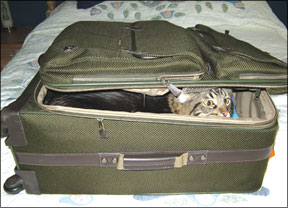Sooner or later, most people find themselves moving to a new home. The experience can be daunting for all concerned. Amazingly enough, as long as they have their special people, most cats seem to adapt to new surroundings with no trouble at all. Still, a little prior planning can smooth the way. Lets examine some potential problem areas.

Bev Caldwell
288
It is of course both normal and desirable for a cat to explore a new environment. A bit of care must be taken so that one does not lose ones cat. Take time to block any openings that would allow a cat to reach areas that you yourself could not access should the need arise. Otherwise, you could find yourself cutting holes in sheetrock, disconnecting your home theatre or even removing plumbing fixtures to retrieve a frightened feline.
In fact, if your new home is quite large, you might want to use gates or doors to initially limit the areas that your cat can access without supervision. Offer an assortment of cat-friendly mats and perches in these areas. As you offer access to more areas of the house, begin to move these familiar beds to the new locations. Do scan each new area for any toxic materials or other dangerous situations.
To Sleep or Not to Sleep
Encouraging exploration during the day is a good idea. When your cat’s activity level remains high throughout the night, our ability to get a good nights sleep can be impacted. Sleep is even harder to come by when a cats activity is accompanied by vocalization. Oftentimes, cats are restless in the evening simply because they cannot find a suitably safe resting place. As described in the previous section, your cat is more likely to sleep soundly if he has been introduced to an assortment of suitable cat beds or perches.
Theres No Place Like Home
Just as we personalize our new home with a fresh coat of paint, cats personalize new environments by marking. Some cats mark surfaces with their cheek glands, other cats deposit dabs of urine, which isnt too pleasant.
Allowing your cat to acclimate to one or two rooms at a time may reduce his drive to mark. When you are home, you may let your cat explore. Be prepared to use distractions to interrupt preludes to urine marking. Excessive sniffing of surfaces, particularly when accompanied by tail flicks, is a warning sign. Plugging some feline pheromone diffusers (Feliway) in socially significant areas may also serve to increase comfort and discourage marking.
Sometimes, although a cat may appear perfectly content in his new home, there is a telltale sign of trouble: The litter box is barely touched. You placed the box in the spare bathroom, just as it was in your former home. You showed it to him when you arrived. Why is it empty?
Your first appropriate thought should be that perhaps your cat is obstructed or constipated. You bring him to his veterinarian who declares that he is healthy and that his bladder and colon are empty. Clearly he must be eliminating somewhere. So you begin your methodical search for evidence, and you are rewarded: You find some stool which has been deposited behind the television. And then you discover that the cubby under the window seat is damp and smells suspiciously like urine.
What went wrong? In many cases, particularly when cats are moved from a small home to a much larger one, they are just not spending much time in the area that contains the litter box. Rather than walking all the way across the house just to eliminate, the cat may test a new location or substrate. Any hidden corner will serve the purpose of keeping feces out of ones main living area. (Plush carpet or down comforters will pass a urine absorbency test with flying colors
Here is another situation where an ounce of prevention will be well worthwhile. When you arrive at your new house, set out several litter boxes. Let your cat tell you which locations he favors. Once his good habits are established, you can remove some of the boxes.
How many boxes are needed? In most cases, one box per floor should suffice for a single cat or a pair of compatible cats. Do place one box in a room that resembles the litter box location in your former home. Any additional boxes should be visible and accessible.
Should you discover that your cat is not settling in nicely, plan to consult with a behaviorist. Together, you will surely find a way to convince your cat that theres no place like home.



